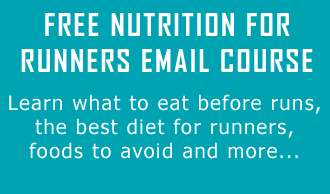I was obsessed with healthy eating long before I was obsessed with running. As a college student, I lost weight and my health suffered. Now I know I experienced orthorexia, an unhealthy fixation on eating healthy foods. I was literally studying food to earn a bachelor’s degree, which fueled myriad disordered eating behaviors and patterns in my early twenties.
At age 22 I started training for my first half-marathon. I immediately thought of food differently. Without it, my training would suffer. With it, I could help my body run farther. It would take a few more years to distinguish the two on at least one level. I don’t have to run to eat, but I do have to eat to run.
- Bonus Content – Check the bottom of this post to watch an interview with nutritionist and author of this article Heather Caplan as she shares even more on this important subject.
Orthorexia is recognized by eating disorder professionals nationwide
The National Eating Disorder Association (NEDA) acknowledges that while Orthorexia Nervosa is not yet a diagnosable disorder, “recovery can require professional help.” On NEDA’s website, under “Special Issues”, Dr. Karin Kratina RD, LDN, PhD, notes that Orthorexia often begins as “an innocent attempt to eat more healthfully, but orthorexics become fixated on food quality and purity.”
Many runners experience the opposite of my Orthorexia experience. More often, as people start to run or train for their first big race, nutrition comes into focus. It’s an aspect of training they can control. Runners experiment with gels, blocks, chews, and the “perfect” long run meals. They learn what works for them, and what doesn’t. Curiosity lingers, even when these experiments yield successful results.
Could I do more, run faster, further, using less fuel? Starting as an innocent attempt to be healthier, or run farther and faster, can quickly become an obsession with healthy eating known as Orthorexia.
Orthorexia plagues the running community
It can be asymptomatic, seeming harmless for weeks, months, or even years. Orthorexia wears many disguises and is often hard to identify. But it can quickly become all consuming, and soon those improvements in speed or distance plateau, then reverse, as the body struggles to function without enough fuel or nutrients.
Long term consequences may include the Female Athlete Triad (Protect Yourself From the Female Athlete Triad), stress fractures, and chronic fatigue.
This fixation on eating healthy all day every day, often results in underfueling both in overall energy and micronutrients (vitamins and minerals). It also takes precedence in the mind, leaving little room for the mental energy that training, and life, require.
Are you a vegetarian and a runner? Then you need to read 4 Nutritional Priorities as a Vegetarian Runner.
Orthorexia looks different for each person
It often starts with a set of food rules or guidelines someone follows to try and get healthier. As a dietitian and running coach, I understand how runners are susceptible to this eating pattern. It provides structure, rules, and a sense of accomplishment. Much like training. Changing food habits and learning more about nutrition can be helpful. Though it often starts with good intentions, it can easily be taken too far.
- Ask yourself: Do food rules help, or harm, your training? Where do you draw the line? How will you know if you’ve crossed it? Would it be helpful to talk to a sports dietitian or disordered eating specialist?
I spoke with a few runners willing to share their personal experiences with Orthorexia. These unique tales highlight the many faces, signs, and symptoms of this disordered eating pattern.
Jessica Hofheimer, a running coach, mom of three, and entrepreneur, recently shared her personal Orthorexia story via Instagram.
“My sickness was masked by my ‘success’ as a runner,” she writes in the Instagram caption. She adds that because she ran faster as she lost weight, she thought she was “fine.” Running wasn’t the first trigger for her. As we spoke, she made an important point: “I never ‘named’ my issue because it didn’t seem severe enough to be an eating disorder.”
Eating disorder stereotypes give us a skeletal, dire picture. Orthorexia is one of many eating disorders that may not present with extreme weight loss. She adds, “By other definitions, I was in good health. I still had my period. I didn’t have any stress fractures. And I was receiving praise for my faster running times and PRs!”
Another key point she made is that Orthorexia isn’t about eating healthy 100 percent of the time.
“I was in a deep calorie deficit by the end of every day. I under-fueled throughout the day, ate a light dinner, then had ice cream or some other dessert. To me, this “junk food” was justification that I didn’t have an eating disorder.” But food was always on her mind. That unhealthy fixation can apply to other aspects of eating; it doesn’t imply the person exclusively eats “healthy” foods.
Runner’s Connect editor, Tony Pallotta, readily opens up about his own brush with Orthorexia. His story involves a fixation on specific nutrients as they relate to performance.
“Last year I was training for an ultra (my 10th). I started eating about a pound of spinach a week. I love spinach salad. But I was noticing excessive fatigue. I almost felt poisoned.”
Tony learned his body has a high capacity to store iron, which led to early symptoms of iron toxicity (overdose). One step to correcting the issue for him involved donating blood, reducing the concentration of iron in circulation. For more, please read Iron Deficiency In Runners
In other cases, Orthorexia can lead to severe restriction
Avid distance runner and journalist Mario Fraioli, author of a popular weekly newsletter the morning shakeout, shared how his eating disordered plagued the early stage of his post-collegiate running career.
“I was interested in aspects of my running that I had complete control over and could tweak and optimize in the name of performance. Nutrition fell into that category.” His goal was to improve performance. “I thought that if I ate healthier foods I could (and should) eat less of them, which didn’t end well for me,” he notes.
Mario’s story also highlights the many ways Orthorexia leads to self-justifications. He adds, “In the moment, I would have told you that I had cleaned up my diet and was focusing on quality over quantity. In retrospect, it was disordered eating, “healthy” was a justification for “less,” and I wasn’t fueling myself properly by any definition.”
In each case above, including my own, a lack of knowledge and self-awareness allowed the disorder to develop and disguise itself as “healthy.” Athletes of any level are at risk for developing disordered eating patterns, which puts them at risk for chronic fatigue, injuries, and impaired health. With knowledge and support, recovery is possible.
If any of the above sounds familiar to you, consider reaching out to a friend, family member, and healthcare provider. A sports dietitian, therapist, and physician may all be helpful in the process.
For more on nutrition for runners, please read 5 Tips to Get Back on Track With Your Nutrition, 3 Tips To Stay Healthy and Run Well While Traveling and Mindful Eating For Runners.







